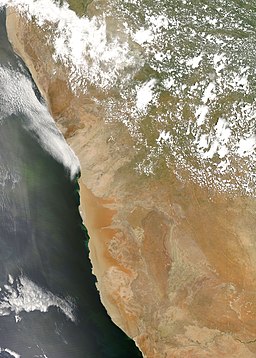"Namib" redirects here. It is not to be confused with Namibia or Namibian (disambiguation).
| Namib Desert | |
| Desert | |
|
An image of the Namib Desert by the MODIS satellite
| |
| Countries | Namibia, Angola |
|---|---|
| Landmarks | Namib-Naukluft National Park,Naukluft Mountains,Skeleton Coast, Spitzkoppe,Sossusvlei, Deadvlei, Sperrgebiet |
| Rivers | Swakop River, Kuiseb River,Cunene River, Orange River,Olifants River, Tsauchab |
| Highest point | Brandberg Mountain 2,606 m (8,550 ft) |
| - location | Erongo, Namibia |
| - coordinates | 21°07′S 14°33′E |
| Lowest point | Atlantic Ocean 0 m (0 ft) |
| Length | 2,000 km (1,243 mi), N/S |
| Width | 200 km (124 mi), E/W |
| Area | 81,000 km2 (31,274 sq mi) |
| Biome | Desert |
The Namib is a coastal desert in southern Africa. The name Namib is of Nama origin and means "vast place". According to the broadest definition, the Namib stretches for more than 2,000 kilometres (1,200 mi) along the Atlantic coasts of Angola, Namibia, and South Africa, extending southward from the Carunjamba River in Angola, through Namibia and to the Olifants River in Western Cape, South Africa.[1][2]The Namib's northernmost portion, which extends 450 kilometres (280 mi) from the Angola-Namibia border, is known as Moçâmedes Desert, while its southern portion approaches the neighboring Kalahari Desert. From the Atlantic coast eastward, the Namib gradually ascends in elevation, reaching up to 200 kilometres (120 mi) inland to the foot of the Great Escarpment.[1] Annual precipitation ranges from 2 millimetres (0.079 in) in the most arid regions to 200 millimetres (7.9 in) at the escarpment, making the Namib the only true desert in southern Africa.[1][2][3] Having endured arid or semi-arid conditions for roughly 55–80 million years, the Namib may be the oldest desert in the world.[1][3]


